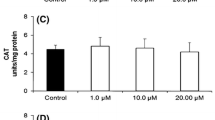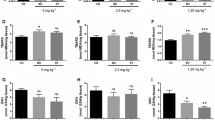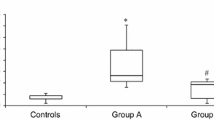Abstract
Malondialdehyde (MDA) derivatives occur as normal constituents of rat and human urine. In a previous study, it was found that MDA excretion in rats is responsive to MDA intake and to certain factors that increase lipid peroxidation in vivo: vitamin E deficiency, iron administration and a high concentration of cod liver oil (CLO) fatty acids in the tissues. In the present study, the effect on MDA excretion of several additional dietary and endogeneous factors was evaluated.
The composition of dietary fatty acids had a major influence on MDA excretion in fed animals, being highest for animals fed n−3 fatty acids (20∶5 and 22∶6) from CLO, intermediate for those fed n−6 (18∶2) acids from corn oil (CO) and lowest for those fed saturated acids from hydrogenated coconut oil (HCO). Diet was the main source of urinary MDA in all groups. Fasting produced a marked increase in urinary MDA, which tended to be higher in rats previously fed CLO. Fasting MDA excretion was not affected by the level of CO in the diet (5, 10 or 15%), indicating that feeding n−6 acids does not increase lipid peroxidation in vivo. Adrenocorticotropic hormone and epinephrine administration increased urinary MDA, further indicating that lipolysis either releases fatty acid peroxides from the tissues or increases the susceptibility of mobilized fatty acids to peroxidation. A decrease in fasting MDA excretion was observed in rats previously fed a high level of antioxidants (vitamin E+BHT+vitamin C) vs a normal level of vitamin E. MDA excretion increased following adriamycin and CCl4 administration. No increase was observed following short-term feeding of a choline-methionine-deficient diet, which has been reported to increase peroxidation of rat liver nuclear lipids.
This study provides further evidience that urinary MDA can serve as a useful indicator of lipid peroxidation in vivo when peroxidation of dietary lipids is precluded.
Similar content being viewed by others
Abbreviations
- MDA:
-
malondialdehyde
- PUFA:
-
polyunsaturated fatty acids
- ACTH:
-
adrenocorticotropic hormone
- EP:
-
epinephrine
- HCO:
-
hydrogenated corn oil
- CO:
-
corn oil
- CLO:
-
cod liver oil
- HPLC:
-
high performance liquid chromatography
- FFA:
-
free fatty acids
- CMD:
-
choline-methionine-deficient
- EFA:
-
essential fatty acids
References
Draper, H.H., Polensek, L., Hadley, M., and McGirr, L.G. (1984)Lipids 19, 836–843.
Bird, R.P., Hung, S.S.O., Hadley, M., and Draper, H.H. (1983)Anal. Biochem. 128, 240–244.
Falholt, K., Lund, B., and Falholt, W. (1973)Clin. Chim. Acta 46, 105–111.
Lee, N.S., Draper, H.H., and Hadley, M. (1982)J. Nutr. 112, 211–215.
Blum, R.H., and Carter, S.K. (1974)Ann. Intern. Med. 80, 249–259.
Young, R.C., Ozols, R.F., and Myers, C.E. (1982)N. Engl. J. Med. 305, 139–145.
Myers, C.E., McGuire, W.P., Liss, R., Ilfrim, I., Grotzinger, K., and Young, R. (1977)Science 197, 165–167.
Rushmore, T.H., Lim, Y.P., Farber, E., and Ghoshal, A.K. (1984)Cancer Lett. 24, 251–255.
Reddy, K., Fletcher, B., Tappel, A., and Tappel, A.L. (1973)J. Nutr. 103, 908–915.
Iritani, N., Fukuda, E., and Kitamura, Y. (1980)J. Nutr. 110, 924–930.
Draper, H.H., McGirr, L.G., and Hadley, M. (1986)Lipids 21, 305–307.
McGirr, L.G., Hadley, M., and Draper, H.H. (1985)J. Biol. Chem. 260, 15427–15431.
Author information
Authors and Affiliations
Additional information
This research was performed in partial fulfillment of the requirements for the M.Sc. degree in Nutritional Sciences
About this article
Cite this article
Dhanakoti, S.N., Draper, H.H. Response of urinary malondialdehyde to factors that stimulate lipid peroxidation in vivo. Lipids 22, 643–646 (1987). https://doi.org/10.1007/BF02533942
Received:
Issue Date:
DOI: https://doi.org/10.1007/BF02533942




